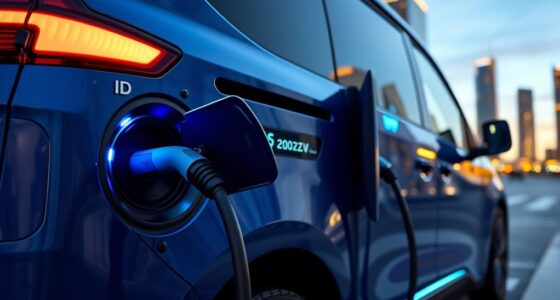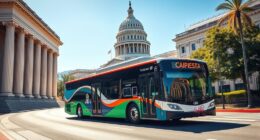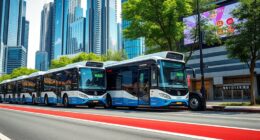In electric bus braking systems, regenerative brakes recover kinetic energy during deceleration and recharge the battery, improving efficiency and extending range. Friction brakes then kick in when more stopping power is needed or if the battery can’t accept charge, ensuring safety and reliability. Using both systems together reduces wear on brake components and lowers maintenance costs. If you’d like to understand how these systems work seamlessly, there’s more to explore below.
Key Takeaways
- Regenerative brakes convert kinetic energy into electrical energy to recharge batteries, extending range and improving efficiency.
- Friction brakes provide reliable stopping power during high deceleration or when regenerative braking is insufficient.
- Combining both systems enhances safety, reduces brake wear, and lowers maintenance costs for electric buses.
- Proper system calibration ensures seamless transition between regenerative and friction braking, maintaining vehicle safety.
- Regenerative braking primarily recovers energy, while friction brakes are essential for emergency stops and high-demand deceleration.

Electric bus braking systems are essential for ensuring safety, efficiency, and performance in modern transit. When you operate or maintain these vehicles, understanding how regenerative and friction brakes work can help you optimize their performance and longevity. Regenerative braking captures kinetic energy during deceleration, converting it into electrical energy that recharges the bus’s battery. This process directly impacts battery efficiency, allowing you to extend the driving range and reduce charging frequency. By recycling energy that would otherwise be lost as heat, regenerative brakes make your bus more energy-conscious and cost-effective to operate. However, they don’t always provide sufficient stopping power on their own, especially in emergency situations or when high deceleration rates are needed. That’s where friction brakes come into play—they use brake pads and discs to generate the necessary friction for stopping. Although traditional, friction brakes are indispensable for safety, especially when regenerative braking alone can’t deliver the required braking force.
From a maintenance perspective, the interplay between regenerative and friction brakes influences how you keep the system in top shape. Since regenerative braking reduces the workload on friction brakes, you generally experience less brake pad wear, which can lower brake maintenance costs over time. Still, it’s imperative to regularly inspect both systems to guarantee they’re functioning correctly. Worn or damaged brake components can compromise safety and lead to costly repairs if neglected. Also, the effectiveness of regenerative braking depends on the battery’s ability to accept charge efficiently. If the battery is less efficient or nearing full capacity, regenerative braking might be limited, placing more demand on friction brakes. This makes routine battery checks and maintenance crucial to maximize the benefits of regenerative systems.
You need to pay close attention to how these braking systems work together, especially since their combined operation affects overall safety and performance. Proper calibration ensures that regenerative braking activates appropriately and that friction brakes engage seamlessly when needed. When you stay on top of brake maintenance, you help prevent issues like overheating or uneven wear, which can compromise safety and increase repair costs. Understanding the balance between these two systems also helps you troubleshoot problems more effectively, such as unusual noises or inconsistent braking responses. Ultimately, combining regenerative and friction brakes in your electric bus isn’t just about safety—it’s about enhancing efficiency, reducing operational costs, and ensuring reliable, long-lasting performance on every route.
Frequently Asked Questions
How Do Regenerative Brakes Impact Overall Energy Efficiency?
Regenerative brakes considerably boost your bus’s energy efficiency by capturing energy during deceleration through energy recovery. This system seamlessly integrates with the overall braking process, reducing reliance on friction brakes and conserving power. As a result, you’ll notice lower energy consumption, extended battery life, and improved operational efficiency. By utilizing regenerative braking, you maximize energy recovery, making your electric bus more eco-friendly and cost-effective over its lifespan.
Are Regenerative Brakes Suitable for All Electric Bus Models?
Regenerative brakes aren’t suitable for all electric bus models because their effectiveness depends on system integration and battery longevity. You’ll find they work best in buses designed to recover energy efficiently and support frequent braking cycles. If your bus’s system isn’t calibrated for regenerative braking, it may not deliver the anticipated energy savings or battery benefits. Always check compatibility with your bus’s design to ensure peak performance and longevity.
What Maintenance Differences Exist Between Regenerative and Friction Brakes?
You’ll find that regenerative brakes require less brake pad wear since they use electric energy to slow the bus, reducing the need for frequent pad replacements. In contrast, friction brakes need regular inspection and replacement of brake pads due to wear. Hydraulic system maintenance is more critical for friction brakes, as it involves fluid checks and repairs, whereas regenerative systems have fewer hydraulic components, simplifying maintenance overall.
How Do Braking Systems Affect Passenger Comfort During Stops?
Braking systems influence your passenger comfort by affecting seat comfort and noise levels. Regenerative brakes provide smoother stopping, reducing sudden jolts and making the ride more comfortable. They also operate quietly, minimizing noise during stops. Friction brakes may cause more abrupt decelerations and louder sounds, which can disturb passengers. Choosing regenerative braking enhances overall comfort, ensuring a quieter, smoother experience, especially during frequent stops.
Can Regenerative Braking Fully Replace Traditional Friction Brakes?
Regenerative braking can’t fully replace traditional friction brakes because brake integration is essential for safety and efficiency. While regenerative systems help extend battery lifespan by recapturing energy, friction brakes provide reliable stopping power in emergencies. You rely on both systems working together, with regenerative braking handling most stops and friction brakes engaging when needed, ensuring safety and preserving battery life.
Conclusion
In the end, choosing between regenerative and friction brakes for electric buses depends on your priorities—efficiency or reliability. While regenerative braking offers a futuristic way to recapture energy, friction brakes remain your trusty, old-school backup, much like a trusty steed in a medieval joust. Embracing both guarantees your bus stays safe and eco-friendly on the road. So, whether you’re riding into the sunset or through the city streets, your braking system’s got your back—no need for a time machine.









